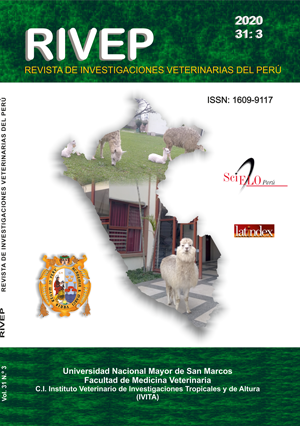First record of Piscinoodinium pillulare (Dinoglagellida) infestation in juveniles of Colossoma macropomum (Characiformes: Serrasalmidae) in semi-intensive fish farming in Loreto, Peru
DOI:
https://doi.org/10.15381/rivep.v31i3.16662Keywords:
Colossoma macropomum, Piscinoodinium pillulare, culture, fish farm, PeruAbstract
The aim of this study was to describe a case of Piscinoodinium pillulare infestation and mortality in juveniles of Colossoma macropomum. In March 2019, 21 juvenile specimens of a semi-intensive fish farm were collected in the Maynas area, Loreto (Peru). Parasitological analysis of the external parts of the fish was performed and the presence of P. pillulare located on the skin, fins, gills, and nostrils was observed. Furthermore, a 30% mortality was recorded (1500 out of 5000 seeded). The non-disinfection of the pond, the inadequate control in the feeding, and the proliferation of Oreochromis niloticus (tilapia) in the culture were the causes of the proliferation of P. pillulare. This is the first reported case of P. pillulare infestation in juveniles of C. macropomum grown in the Peruvian Amazon.
Downloads
Downloads
Published
Issue
Section
License
Copyright (c) 2020 Humberto Arbildo Ortiz, Juleysi Alvez-Robledo, Carlos Chuquipiondo Guardia, Amanda Karen Silva de Souza

This work is licensed under a Creative Commons Attribution-NonCommercial-ShareAlike 4.0 International License.
AUTHORS RETAIN THEIR RIGHTS:
a. Authors retain their trade mark rights and patent, and also on any process or procedure described in the article.
b. Authors retain their right to share, copy, distribute, perform and publicly communicate their article (eg, to place their article in an institutional repository or publish it in a book), with an acknowledgment of its initial publication in the Revista de Investigaciones Veterinarias del Perú (RIVEP).
c. Authors retain theirs right to make a subsequent publication of their work, to use the article or any part thereof (eg a compilation of his papers, lecture notes, thesis, or a book), always indicating the source of publication (the originator of the work, journal, volume, number and date).










